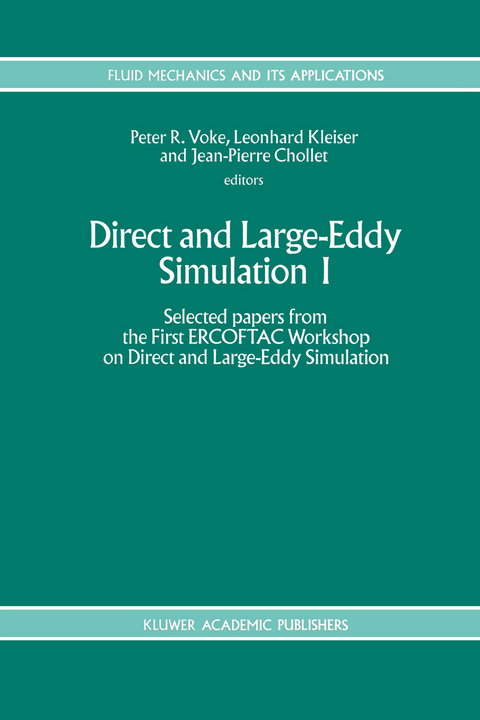
Direct and Large-Eddy Simulation I
Springer (Verlag)
978-94-010-4434-9 (ISBN)
Structures from Simulations.- Large-Scale Structures in the Turbulent Flow Near a Right-Angled Corner.- Very-Large-Scale Structures in DNS.- Eddy Structures in a Simulated Plane Turbulent Jet Educed by Pattern Recognition Analysis.- Subgrid-Scale Modelling.- Experimental Study of Similarity Subgrid-Scale Models of Turbulence in the Far-Field of a Jet.- Direct and Large Eddy Simulations of Round Jets.- Subgrid-Scale Models based upon the Second-Order Structure-Function of Velocity.- Significant Terms in Dynamic SGS-Modeling.- Assessment of the Generalised Normal Stress and the Bardina Reynolds Stress Subgrid-Scale Models in Large Eddy Simulation.- Subgrid-Scale Modelling in the Near-Wall Region of Turbulent Wall-Bounded Flows.- Two-dimensional Simulations with Subgrid Scale Models for Separated Flows.- A Priori Test of a Subgrid Scale Stress Tensor Model Including Anisotropy and Backscatter Effects.- Subgrid-modelling in LES of Compressible Flow.- Stratified and Atmospheric Flows.- Sheared and Stably Stratified Homogeneous Turbulence: Comparison of DNS and LES.- Direct Numerical Simulation of a Stably Stratified Turbulent Boundary Layer.- A Neutral Stratified Boundary-Layer: A Comparison of Four Large-Eddy Simulation Computer Codes.- The Large-Eddy Simulation of Dispersion of Passive and Chemically Reactive Pollutants in a Convective Atmospheric Boundary Layer.- Numerical Simulation of Breaking Gravity Waves below a Critical Level.- Transition.- Stability of the Natural-Convection Flow in Differentially Heated Rectangular Enclosures with Adiabatic Horizontal Walls.- Direct Simulation of Breakdown to Turbulence Following Oblique Instability Waves in a Supersonic Boundary Layer.- Mechanisms and Models of Boundary Layer Receptivity Deduced from Large-Eddy Simulation of By-pass Transition.- Receptivity by Direct Numerical Simulation.- Direct Numerical Simulation of Transition in a Spatially Growing Compressible Boundary Layer Using a New Fourier Method.- Complex Geometries.- Large-Eddy Simulation of Flow and Heat Transfer in Compact Heat Exchangers.- Large-Eddy Simulation of Turbulent Flow through a Straight Square Duct and a 180° bend.- Numerical Simulation of Turbulent Flow over a Wavy Boundary.- Large-Eddy Simulation of Turbulent Boundary Layer Flow over a Hemisphere.- Large-Eddy Simulation of Compound Channel Flow with One Floodplain at Re ? 42000.- Large-Eddy Simulation Applied to an Electromagnetic Flowmeter.- Compressible, Reacting and Thermal Flows.- On the Formation of Small Scales in a Compressible Mixing Layer.- Direct Simulation of Turbulence Phenomena in Compressible Boundary Layers.- DNS of a M = 2 Shock Interacting with Isotropic Turbulence.- Direct and Large Eddy Simulations of Chemically Reacting Flows.- Flow Mechanisms and Heat Transfer in Rayleigh-Bénard Convection at Small Prandtl Numbers.- Direct and Large-Eddy Simulation of Transient Buoyant Plumes: a Comparison with Experiment.- Numerical Investigation of Turbulent Structures in Thermal Impinging Jets.- Numerical Simulations of 2-D Turbulent Natural Convection in Differentially Heated Cavities of Aspect Ratios 1 and 4.
| Reihe/Serie | Fluid Mechanics and Its Applications ; 26 |
|---|---|
| Zusatzinfo | XIV, 434 p. |
| Verlagsort | Dordrecht |
| Sprache | englisch |
| Maße | 160 x 240 mm |
| Themenwelt | Mathematik / Informatik ► Informatik ► Theorie / Studium |
| Mathematik / Informatik ► Mathematik ► Angewandte Mathematik | |
| Naturwissenschaften ► Physik / Astronomie ► Mechanik | |
| Technik ► Maschinenbau | |
| ISBN-10 | 94-010-4434-1 / 9401044341 |
| ISBN-13 | 978-94-010-4434-9 / 9789401044349 |
| Zustand | Neuware |
| Informationen gemäß Produktsicherheitsverordnung (GPSR) | |
| Haben Sie eine Frage zum Produkt? |
aus dem Bereich


